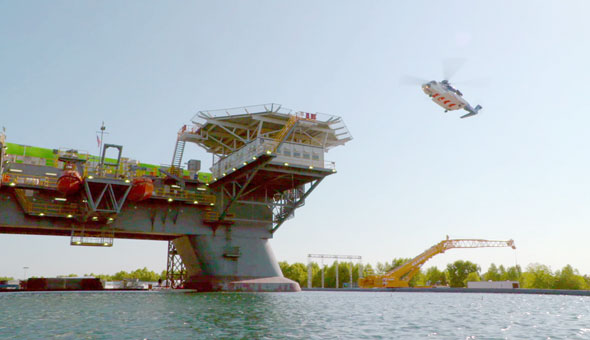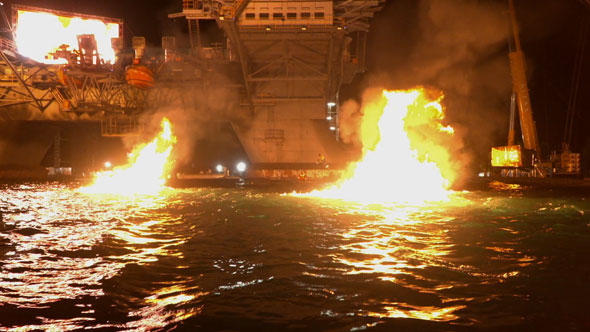Film Facts, Including How and Why the Production Built One of the Largest Sets Ever Constructed
Deepwater Horizon is a disaster movie with tragic undercurrents — the explosive oil-rig blowout depicted in the film took place little more than six years ago, resulting in the deaths of 11. It was an environmental disaster, too, but director Peter Berg's film doesn't deal with that aspect of the story. Instead, it's concerned with the crisis faced by the crew on board the massive rig before and after the explosion took place. "I'm drawn to tales of human courage and of the human spirit trying to triumph over real adversity," said Berg in a statement provided by Lionsgate. "The men and women aboard the Deepwater Horizon were extremely intelligent and capable and they tried everything they could to prevent the blowout …. In the middle of all the deserved attention for the oil spill, that heroism has almost been lost." The production went to extraordinary lengths to capture the environment as it existed on that fateful day. Read on to learn more about the undertaking, including the creation of one of the largest, heaviest movie sets ever constructed.
Deepwater Horizon shot in Southern Louisiana.
Going on location to shoot close to the Gulf of Mexico meant the production had access to oil workers, who were hired as extras and set-builders. It also allowed them to consult with survivors, families of the deceased, and experts on the oil industry. "We had submersible guys working on the submersible scenes and real drillers working in the drill shack scenes," said producer Lorenzo di Bonaventura. "It gives the movie a deeper level of gravity because they each speak in a particular way and they know when something doesn't feel right." [Source: Studio production notes.]
An unhappy BP made problems for the production.
"BP was not particularly thrilled that we were making the film," Berg said in an interview on NPR's Fresh Air. "Not only were they not a big advocate or very supportive, but they actually became a very effective disruptor." The petroleum giant's influence in local communities made it hard for the production to get certain interviews and to secure access to required vehicles. It also meant the filmmakers would not gain access to an actual oil rig. "We tried and were politely but firmly declined … at every turn." [Source: NPR]

The Deepwater Horizon rig was one of the most massive physical sets ever built.
In the parking lot of an abandoned Six Flags theme park, production designer Chris Seagers and a team that included 85 welders spent eight months building a 33,000-ton 85% scale recreation of a deepwater rig on top of a five-acre water tank — one of the largest sets ever built. "This is not a set," Seagers told The New Orleans Times-Picayune during the filming. "This is a major piece of construction…. Then you're setting the whole thing on fire." The whole thing required six 10,000-horsepower engines with satellite communications to keep the rig stable, and included a functioning helipad for an actual Chinook helicopter landing. Finding references for authenticity was a challenge since the actual Deepwater Horizon was destroyed. "We only had four photographs [of the bridge] and none showed all of the bridge," Seagers said, "so we had to call the manufacturer of the equipment and they kindly gave us a layout of how the bridge was formed." [Source: New Orleans Times-Picayune, NPR, studio production notes]

Even the water tank was huge.
The main water tank held more than two million gallons and took three days to fill. In order to simulate the blaze of oil on the water's surface, liquid propane was poured in and set aflame. [Source: Studio production notes]
Cinematographer Enrique Chediak chose dark, gritty references for inspiration.
Chediak said his work on the film was inspired by images made in the early 1990s, after the first Gulf War: Brazilian photographer Sebastião Salgado's images of oil-rig workers and firefighters in Kuwait as well as director Werner Herzog's 16mm classic Lessons of Darkness, a documentary study of the otherworldly Kuwaiti oil field fires. "What drew me to the Salgado pictures, even though they're black and white, is their level of contrast, the level of shininess," Chediak said. "To do something similar, we really emphasized the sweat and the mud and the darkness on the rig workers after the blowout." [Source: Studio production notes]

Practical effects were used wherever possible.
Deepwater Horizon joined a growing trend of generating as many effects as possible on set and getting them in camera, rather than relying on VFX to create them in post. For example, the filmmakers used large screens playing back images of huge flames to create the correct interplay of light and shadow on set. "They have these 30-foot-by-30-foot LED screens," special effects supervisor Burt Dalton told the Los Angeles Times. "They flew that up on the deck. Visual effects needed all the light effects and shadow effects that would have been impossible to add in post. They took footage [of fire] and blew it up so it would give the exact color and flicker of a real giant flame." [Source: Los Angeles Times]
ILM, Iloura, Base FX and Hybride contributed VFX, but they're mostly invisible.
For example, even though the physical Deepwater Horizon rig was huge, it required set extensions to match the full profile of the real thing. "I did two big CG-type films, Battleship and Hancock," Berg told IndieWire. "No regrets, but the reality is, a movie like Deepwater has as much CG as either one of those. You just won't really notice it. That's what I prefer doing. I don't mind CG, but I prefer these kinds of stories." [Source: IndieWire]
Deepwater Horizon is now playing in North America and around the world, with more territories to follow.
Did you enjoy this article? Sign up to receive the StudioDaily Fix eletter containing the latest stories, including news, videos, interviews, reviews and more.










Leave a Reply